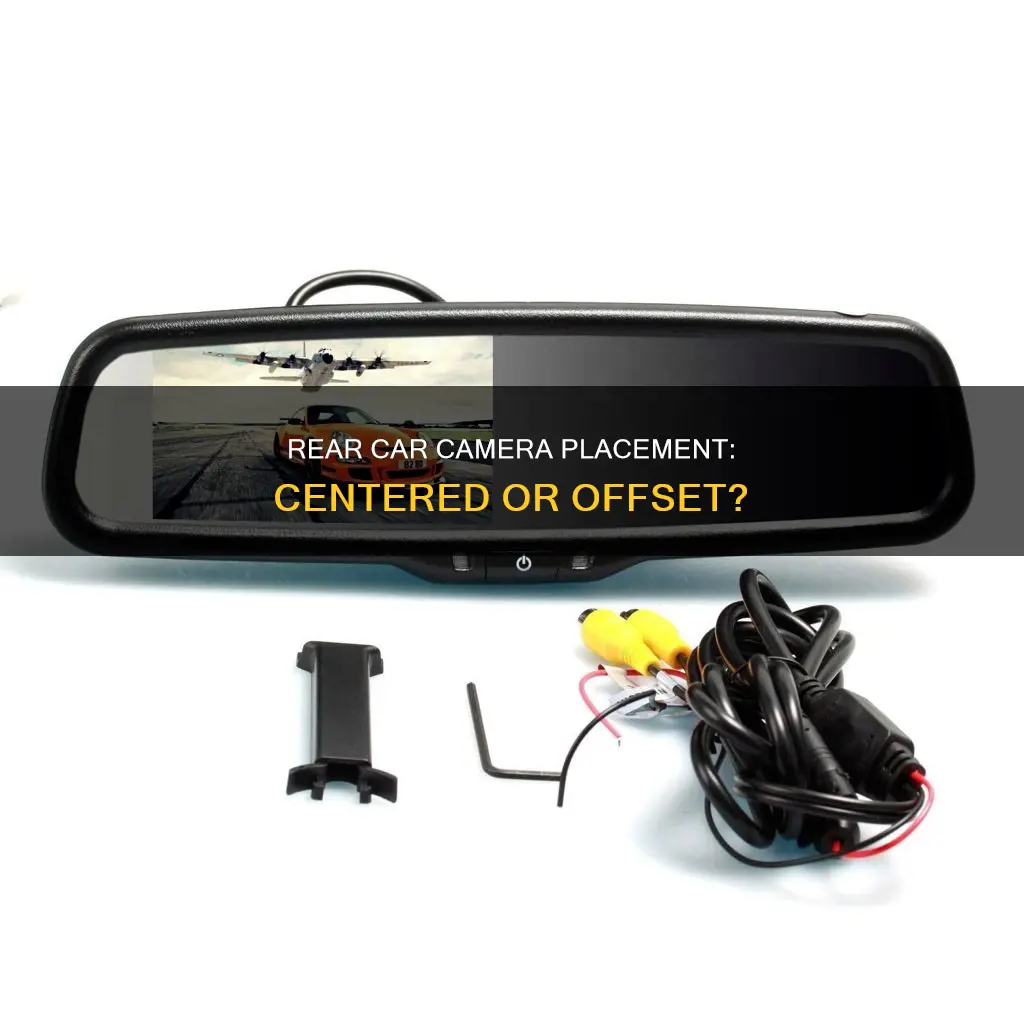
Backup cameras, also known as rearview cameras, are now standard equipment on all new passenger cars, trucks, and vans weighing less than 10,000 pounds, as of May 2018. These cameras improve safety by helping drivers see what's directly behind their vehicle and eliminating blind spots. While backup cameras are typically mounted in the center of the vehicle's rear trim pieces, some makes and models have offset cameras that are not centered. This can be due to the placement of the license plate or other features, such as the trunk release, being in the center. While a centered camera can provide a more accurate view, an offset camera can still be effective, especially with adjustable guidelines.
| Characteristics | Values |
|---|---|
| Do car rear cameras have to be centered? | No, many car models have offset cameras. |
| Are there any benefits to having a centered camera? | A centered camera can help the driver park more accurately and avoid obstacles. |
| Are there any drawbacks to having an offset camera? | An offset camera may be annoying for the driver, and it may be more difficult to adjust the guidelines to get an accurate view. |
| Can a car rear camera be adjusted? | Yes, some cameras can be adjusted to correct the view if it is not centered. |
What You'll Learn

Rearview cameras are now legally required in new vehicles
Rearview cameras are now legally required in all new vehicles sold in the US. As of May 2018, all manufacturers in the US are required to install a reversing camera in new vehicles. This law was passed by Congress in 2008, but its implementation was delayed for several years. Finally, in 2014, the Department of Transportation announced the effective date of May 2018, providing manufacturers with time to implement the technology.
The requirement for backup cameras is driven by the need to address blind spots and improve rear visibility for drivers. Many accidents occur when drivers unintentionally strike pedestrians, objects, or other vehicles while reversing. Backup cameras provide a clear view of the area behind the vehicle, enhancing safety and reducing the risk of such accidents. According to the National Highway Traffic Safety Administration, 221 people were killed by non-traffic backover crashes in 2007, and 14,000 people were injured.
The benefits of having a backup camera in a car include increased safety and a reduced risk of accidents while reversing. Backup cameras also enhance visibility of blind spots behind the vehicle and improve awareness of pedestrians, objects, and other vehicles in the rear area. Additionally, backup cameras can make parking easier and quicker, and help with tasks such as hitching a trailer.
While backup cameras are now standard in new vehicles, they are not a perfect solution. They can be affected by poor image quality due to a dirty lens or interference from other wireless devices. Additionally, they should not be relied upon solely, as they can malfunction or fail to work due to electrical issues. It is important for drivers to continue to use their mirrors and turn around to look when reversing, rather than relying solely on the backup camera.
In terms of the placement of the rearview camera, it does not have to be centred. Many OEM cameras are offset to the left or right. However, some drivers may find that a centred camera provides a better view, particularly when parking in tight spaces or when backing up in an area with obstacles. Ultimately, the decision on where to place the rearview camera depends on personal preference and the specific vehicle.
Finding the Battery on Your Fujifilm Waterproof Camera
You may want to see also

Rearview cameras are not a perfect replacement for mirrors
Firstly, mirrors offer greater clarity and reliability. Camera displays can be affected by inclement weather, poor lighting, and issues with graininess or bad exposure. In comparison, mirrors provide a sharp, true-to-life image that is unaffected by external conditions. Mirrors are also less likely to be affected by issues such as blooming, where bright light causes a camera display to white out.
Secondly, mirrors offer depth perception, which is crucial when deciding to merge lanes or park. The three-dimensional view provided by mirrors allows for better judgment of distance, whereas camera displays offer a two-dimensional image that can be more challenging to accurately interpret.
Thirdly, mirrors are dead-nuts reliable. They are simple in their design and do not require power, wiring harnesses, or other complex components to function. In contrast, cameras can be more prone to failure due to issues with wiring, cameras, lenses, or screens.
Additionally, mirrors are often preferred for their simplicity and ease of use. While cameras can provide a wider field of view and enhance visibility in certain situations, such as backing up or parking, they may also introduce complexities that some drivers find unnecessary or distracting.
Lastly, mirrors are typically more cost-effective and easier to maintain than camera systems. The cost of purchasing and installing a camera system can be significantly higher than that of mirrors, and replacement or repair costs for cameras and associated components can also be higher.
In conclusion, while rearview cameras offer many benefits and enhancements, they also come with their own set of limitations and challenges. Therefore, it is essential to recognize that mirrors still play a vital role in ensuring safety and functionality and are not yet ready to be replaced entirely by camera systems.
Focus Peaking: Which Cameras Offer This Feature?
You may want to see also

Backup cameras can help you park more quickly and safely
Backup cameras, or rearview cameras, are extremely helpful when it comes to parking your car. They can help you park more quickly and safely, and are now mandatory in all new vehicles sold in the US.
When you put your car into reverse, a camera mounted at the rear of the vehicle turns on and sends an image to a monitor, showing what's behind you. This image is a mirror image, so the orientation is correct when you look at it. Backup camera systems are fairly sophisticated, and they're becoming more high-tech all the time.
Where Are Backup Cameras Mounted?
Backup cameras are usually mounted in the vehicle's rear trim pieces, such as in the bumper, near the license plate, in the trunk lid, or in the tailgate of an SUV or pickup truck. They are fairly unobtrusive and can be hard to spot. The cameras are typically aimed at a downward angle to provide the best view immediately behind your car, and they have wide-angle lenses to give you a comprehensive image.
Where Is the Monitor Located?
The monitor for the backup camera can be mounted anywhere in the driver's field of vision, but it's usually in the center area of the cockpit. Newer vehicles often use the existing screen for the entertainment system, climate control, or navigation as the monitor for the backup camera. Some versions use a portion of the rearview mirror as a monitor, which has the advantage of being where drivers are used to looking when backing up. However, this type of monitor is smaller and provides a less detailed image.
Benefits of Backup Cameras for Parking
Backup cameras give the driver a clearer and more accurate view of obstacles behind the car. Most backup systems include a warning tone that alerts you when you're getting too close to an object. The cameras also feature on-screen guidelines—two parallel lines that help direct you into or out of parking spaces more easily. Some even have a middle line to help you keep the vehicle centered in the space. The guidelines can change colour from green to yellow to red as you get closer to an obstruction, and this, combined with an audible warning, can help prevent accidents.
Drawbacks of Backup Cameras
While backup cameras are extremely helpful, they don't provide a full view of your surroundings. Most cameras only provide an 80-degree field of view behind the vehicle, leaving 280 degrees unaccounted for. This is why it's important not to rely solely on the backup camera when parking, but also to use your side mirrors, review mirror, and turn your head to check for people, vehicles, or objects.
Surveillance Cameras on Halloween: Tricks and Treats
You may want to see also

Backup camera systems are fairly sophisticated pieces of technology
The design of a backup camera is distinct from other cameras because the image is flipped horizontally to produce a mirror image. This is necessary because the camera and the driver face opposite directions. Without this adjustment, the camera's right would be on the driver's left, and vice versa. This mirrored image makes the orientation of the display consistent with the physical mirrors on the vehicle.
Backup cameras typically use wide-angle or fish-eye lenses, which allow the camera to see an uninterrupted horizontal path from one rear corner to the other. The camera is usually pointed at a downward angle to view potential obstacles on the ground.
The cameras are generally installed in the vehicle's rear trim pieces and are often hidden in the bumper, near the license plate, in the trunk lid, or in the tailgate of an SUV or pickup truck. They are unobtrusive and can be hard to spot. The monitors can be mounted anywhere in the driver's field of vision but are typically found in the center area of the cockpit, often using the existing screen for the entertainment system, climate control, or navigation.
Backup cameras have several advantages. Firstly, they help to avert injury-causing and potentially fatal backover accidents by expanding the driver's field of vision, particularly below the rear window or trunk level. They also increase the ability to see beyond the width of a mirror's image, helping to eliminate blind spots. Backup cameras can also assist in parking more quickly and safely by providing a clearer view of obstacles and often include warning tones that alert the driver when they are too close to an object.
Additionally, backup cameras feature on-screen guidelines that help direct the driver into or out of parking spaces. Some systems also change the color of the guidelines from green to yellow to red as the vehicle gets closer to an obstruction, further enhancing safety.
While backup camera systems offer many benefits, they are not perfect and can be affected by issues such as poor image quality due to a dirty lens or interference in wireless systems. It's important to remember that backup cameras are not a replacement for mirrors or physically turning to look but rather an additional safety tool.
Keeping Your Camera Focused on a Jib Crane
You may want to see also

Aftermarket backup cameras are available for older cars
Since 2018, it has been a legal requirement that all new cars sold in the US and Canada must be equipped with a backup camera. However, this only applies to new cars, and most cars on the road today do not have a reverse camera. This is where aftermarket backup cameras come in.
Aftermarket backup cameras can be purchased from retailers such as Amazon, Best Buy, and Crutchfield, with prices ranging from less than $10 for a basic stand-alone camera to over $500 for a complete setup with a camera, transmitter, and display.
There are a few things to consider when shopping for an aftermarket backup camera. Firstly, you will need a monitor to pair with the camera. Many modern vehicles have factory-installed touchscreens or monitors that can be used, or you may need to purchase a separate monitor. Secondly, you will need to decide on the type of camera you want. Wired cameras require running wires inside your car, which can be a complex process, but they draw power from the vehicle's electrical system and don't need to be recharged. Wireless cameras, on the other hand, are much easier to install but may suffer from connection issues and will need to be recharged or supplemented with solar cells.
When choosing a backup camera, it is also important to consider the viewing angle, especially depending on the height and type of your vehicle. A wider viewing angle is generally better, providing a more comprehensive image and helping to eliminate blind spots. Additionally, some cameras offer additional features such as night vision, motion detection, and parking guidelines, which can be very useful in preventing accidents.
Overall, adding an aftermarket backup camera to an older car can be a great way to improve safety and visibility when reversing or parking.
Portrait Mode: Which Cameras Have This Feature?
You may want to see also
Frequently asked questions
No, they don't. Many car manufacturers place the rear camera off-center, usually to the left of the centerline of the car.
Car rear cameras are often placed off-center due to the presence of other components, such as the trunk release, in the center.
No, you don't need to adjust an off-center camera. You can rely on your driving skills and use the camera as a guide to park accurately.
A centered rear camera can provide a more accurate view of the centerline, making it easier to park straight and centered in a parking space.
Yes, you can adjust the guidelines on your rear camera to compensate for any offset. This can help improve the accuracy of the guidelines when parking.







